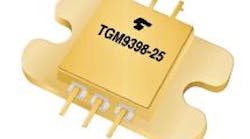Solid-state power transistors continue to gain on vacuum tubes, as device manufacturers explore the capabilities of newer materials, such as gallium nitride (GaN). At this year’s IEEE International Microwave Symposium (IMS) in Montreal, Canada, for example, Toshiba America Electronic Components (TAEC; www.toshiba.com/taec) shows impressive GaN progress in both discrete-device and monolithic forms, with a power transistor for Ka-band satellite communications (satcom) use and an X-band monolithic-microwave-integrated-circuit (MMIC) amplifier for radar applications, respectively. The devices will help simplify designers’ tasks for satellite-communications (satcom) applications.
The firm points to increasing use of satcom services, in particular at Ka-band frequencies, as driving the development of the power transistors. With the growth of high-definition video broadcast and broadband data communication services, the company is planning to release a complete family of Ka-band products for amplifier designers, including the new GaN MMIC amplifier. It offers target specifications of 15 W output power from 29 to 31 GHz with 15-dB typical linear gain when operating from a +15-VDC supply. The MMIC amplifier achieves typical power-added efficiency of 20%. "As a longtime supplier of high-performance GaN and gallium arsenide microwave devices for wireless applications in various frequency bands, Toshiba plans to continue efforts to expand the product line with new solutions," says Homayoun Ghani, Business Development Manager, Microwave Devices, for TAEC’s Discrete Business Unit.
At IMS, TAEC’s parent company, Toshiba Corp., introduced a GaN hybrid IC (HIC). Available in small, hermetically-sealed packages, it is targeted at transmitter and receiver modules (TRMs) used in radar applications—such as active-electronically-scanned-array (AESA) and passive-electronically-scanned-array (PESA) systems. The model GaN X-band HIC, model TGM9398-25 (Fig. 1), is designed to deliver 25 W (+44 dBm) output power at 1-dB compression from 9.3 to 9.8 GHz with power-added efficiency of 35%. It provides linear gain of typically 25 dB. The new device is in a package that is footprint-compatible with the existing discrete internally-matched GaN HEMT, to support easy upgrades for legacy designs.
1. Model TGM9398-25 is a hybrid integrated circuit (HIC) based on GaN substrate material. The amplifier produces 15 W output power with 15-dB linear gain from 29 to 31 GHz for expanding services.
At IMS, the firm also launched a high-electron-mobility-transistor (HEMT) amplifier based on GaN (model TGI1314-25L), nominally for Ku-band satcom applications. It delivers 25 W (+44 dBm) output power from 13.75 to 14.50 GHz with linear gain of typically 8 dB and typical drain current of 2.5 A at +24 VDC. The rugged solid-state device exhibits minimum third-order intermodulation distortion of −25 dBc and efficiency of typically 29%. The device is designed to provide some flexibility for designers of satcom amplifiers; it gives them a somewhat lower-power device than the 50-W transistor released by Toshiba over two years ago for Ku-band applications.
2. Model TIM5964-16EL is a high-power GaAs transistor aimed at point-to-point and point-to-multipoint applications in the 5.3-to-5.9-GHz band.
Not to be lost amidst the excitement of the GaN product introductions, Toshiba also introduced several C-band GaAs power transistors at IMS, with models TIM5359-16EL and TIM5964-16EL (Fig. 2) intended for point-to-point and point-to-multipoint applications. The former operates in the 5.3-to-5.9-GHz range while the latter is aimed at use from 5.9 to 6.4 GHz. Both are rated to deliver +42.5 dBm (16 W) output power at 1-dB compression and power-added efficiency of 38%.


